Themed collection Editor’s Choice: Scaffold Engineering

Progress in electrospun composite nanofibers: composition, performance and applications for tissue engineering
The discovery of novel methods to fabricate optimal scaffolds that mimic both mechanical and functional properties of the extracellular matrix (ECM) has always been the “holy grail” in tissue engineering.
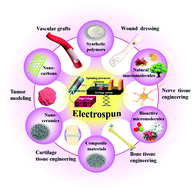
J. Mater. Chem. B, 2019,7, 7075-7089
https://doi.org/10.1039/C9TB01730E
Recent advances in the design of injectable hydrogels for stem cell-based therapy
The recent advances in the design of injectable hydrogels for stem cell delivery, especially for in vivo applications, are overviewed in this review.
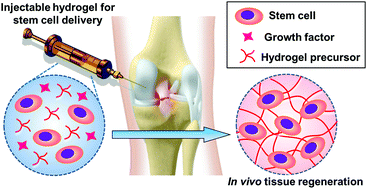
J. Mater. Chem. B, 2019,7, 3775-3791
https://doi.org/10.1039/C9TB00485H
3D printing of ceramic-based scaffolds for bone tissue engineering: an overview
In this review, we systematically highlight the advances in 3D printing of ceramic-based scaffolds for bone tissue engineering.
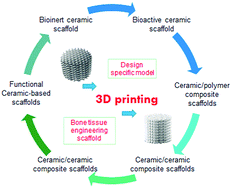
J. Mater. Chem. B, 2018,6, 4397-4412
https://doi.org/10.1039/C8TB00677F
Nanoscale 3D printing of hydrogels for cellular tissue engineering
Two-photon polymerization enables nanoscale 3D printing of hydrogels.
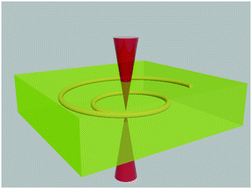
J. Mater. Chem. B, 2018,6, 2187-2197
https://doi.org/10.1039/C8TB00301G
Poly(N-isopropyl acrylamide)–poly(ethylene glycol)–poly(N-isopropyl acrylamide) as a thermoreversible gelator for topical administration
PNIPAM98–PEG122–PNIPAM98 is explored as a thermoreversible gelator for topical administration, giving temperature-dependent release of progesterone over up to 6 days.
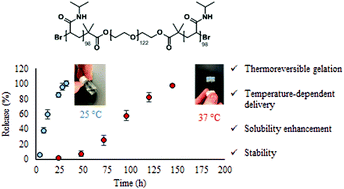
Mater. Adv., 2020,1, 371-386
https://doi.org/10.1039/D0MA00080A
A micropatterned conductive electrospun nanofiber mesh combined with electrical stimulation for synergistically enhancing differentiation of rat neural stem cells
The micropatterned conductive nanofiber mesh combined with ES effectively facilitates the differentiation of NSCs into neuron and suppresses the formation of astrocytes.
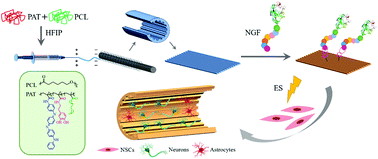
J. Mater. Chem. B, 2020,8, 2673-2688
https://doi.org/10.1039/C9TB02864A
An injectable double-network hydrogel for the co-culture of vascular endothelial cells and bone marrow mesenchymal stem cells for simultaneously enhancing vascularization and osteogenesis
Utilization of a GC/Alg DN hydrogel for the co-culture of BM-MSCs with VECs to promote vascularization and osteogenesis simultaneously.
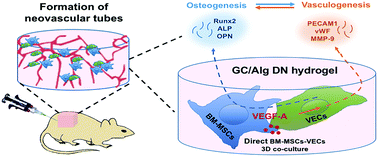
J. Mater. Chem. B, 2018,6, 7811-7821
https://doi.org/10.1039/C8TB02244E
Conductive silk–polypyrrole composite scaffolds with bioinspired nanotopographic cues for cardiac tissue engineering
Imparting electroconductive and nanotopographical cues to biodegradable silk–fibroin films enhanced the maturation of cultured human stem cell-derived cardiomyocytes.

J. Mater. Chem. B, 2018,6, 7185-7196
https://doi.org/10.1039/C8TB01116H
Non-invasive characterization of hybrid gelatin:poly-L-lactide electrospun scaffolds using second harmonic generation and multiphoton imaging
In this work we generated hybrid gelatin:poly-L-lactide electrospun scaffolds and implemented non-invasive methods to characterize them.

J. Mater. Chem. B, 2018,6, 6399-6412
https://doi.org/10.1039/C8TB02026D
Hierarchically structured seamless silk scaffolds for osteochondral interface tissue engineering
Development of a hierarchically analogous biphasic scaffold fabricated in a facile and minimalistic method for repair of osteochondral defect.
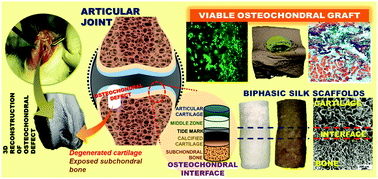
J. Mater. Chem. B, 2018,6, 5671-5688
https://doi.org/10.1039/C8TB01344F
Laser-pattern induced contact guidance in biodegradable microfluidic channels for vasculature regeneration
The induction of contact guidance in HIG-82 and HUVECs on laser-patterned biodegradable scaffolds.
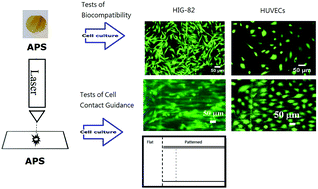
J. Mater. Chem. B, 2018,6, 3684-3691
https://doi.org/10.1039/C8TB00221E
Multidrug-eluting bi-layered microparticle-mesh scaffolds for musculoskeletal tissue regeneration
The differentiation of MSCs into musculoskeletal tissues has been demonstrated using an electrospun, bi-layered micro particle mesh scaffold (BMMS), that can simultaneously host and release up to three bioactive agents.
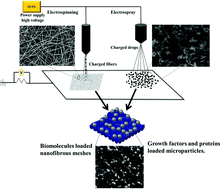
J. Mater. Chem. B, 2018,6, 3340-3347
https://doi.org/10.1039/C8TB00397A
Potential application of an injectable hydrogel scaffold loaded with mesenchymal stem cells for treating traumatic brain injury
In this contribution, we developed an injectable hydrogel composed of sodium alginate and hyaluronic acid that acts as a tissue scaffold to create a more optimal microenvironment for the stem cells for potential application of traumatic brain injury implantation.
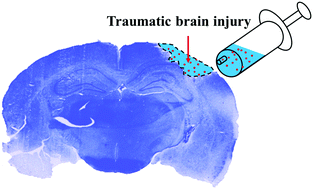
J. Mater. Chem. B, 2018,6, 2982-2992
https://doi.org/10.1039/C7TB03213G
Chondroinductive factor-free chondrogenic differentiation of human mesenchymal stem cells in graphene oxide-incorporated hydrogels
Graphene oxide improves mechanical properties and chondrogenic differentiation state of mesenchymal stem cell-laden, engineered hydrogel constructs, without exogenous chondro-inductive factors.
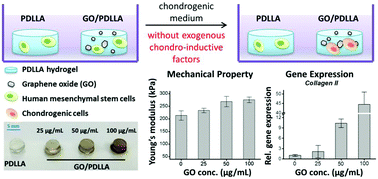
J. Mater. Chem. B, 2018,6, 908-917
https://doi.org/10.1039/C7TB02172K
About this collection
Associate Editor for Journal of Material Chemistry B and Materials Advances, Elizabeth Cosgriff-Hernandez (The University of Texas at Austin, USA) introduces this Editor’s Choice collection on scaffold engineering:
“The truly exciting aspect of tissue engineering is that it harnesses the body’s ability to heal itself. The paradigm shift to working with the body provides numerous opportunities to learn from nature and improve upon current therapeutic strategies. Tissue engineering requires coordination of a multifaceted design that both restores function and guides regeneration. One of the challenges is synthesizing biomaterial scaffolds with appropriate degradation profiles while maintaining appropriate mechanical properties and cell-material interactions. In addition to synthesis of new biomaterials with unique properties, there is also a critical need to advance biomaterial fabrication strategies to achieve greater complexity and function.
In the current collection, I have selected outstanding papers published during recent years in Journal of Materials Chemistry B and Materials Advances that highlight advances in scaffold engineering and biomaterial design for tissue engineering applications. These articles provide exciting results that span multiple fabrications strategies, including hydrogel design and cell carriers, advanced electrospinning of fiber scaffolds, and engineering complex architectures with composites and 3D printing.”